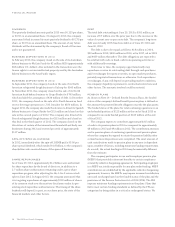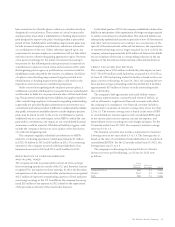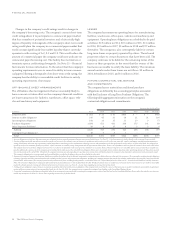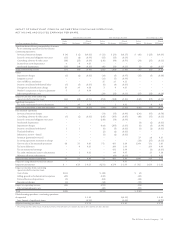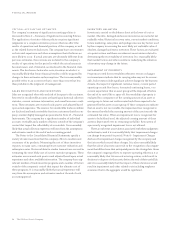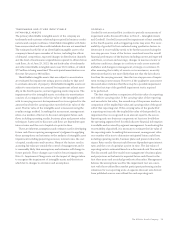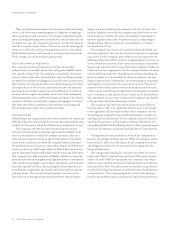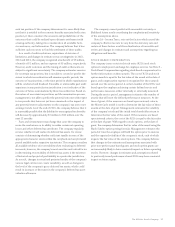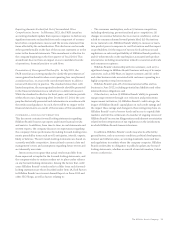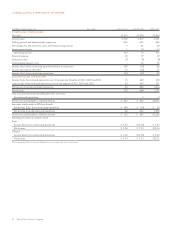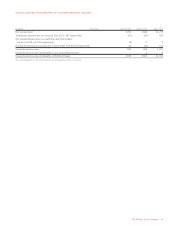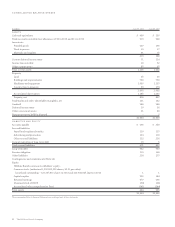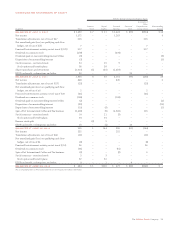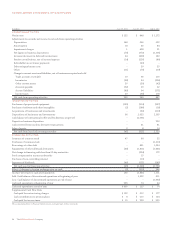Sara Lee 2013 Annual Report Download - page 28
Download and view the complete annual report
Please find page 28 of the 2013 Sara Lee annual report below. You can navigate through the pages in the report by either clicking on the pages listed below, or by using the keyword search tool below to find specific information within the annual report. There are inherent assumptions and estimates used in developing
future cash flows requiring management’s judgment in applying
these assumptions and estimates to the analysis of goodwill impair-
ment including projecting revenues and profits, interest rates, the cost
of capital, tax rates, the company’s stock price, and the allocation of
shared or corporate items. Many of the factors used in assessing fair
value are outside the control of management and it is reasonably
likely that assumptions and estimates can change in future periods.
These changes can result in future impairments.
SELF-INSURANCE RESERVES
The company purchases third-party insurance for workers’
compensation, automobile and product and general liability claims
that exceed a certain level. The company is responsible for the pay-
ment of claims under these insured limits, and consulting actuaries
are utilized to estimate the obligation associated with incurred losses.
Historical loss development factors are utilized to project the future
development of incurred losses, and these amounts are adjusted
based upon actual claim experience and settlements. Consulting
actuaries make a significant number of estimates and assumptions
in determining the cost to settle these claims and many of the factors
used are outside the control of the company. Accordingly, it is reason-
ably likely that these assumptions and estimates may change and
these changes may impact future financial results.
INCOME TAXES
Deferred taxes are recognized for the future tax effects of temporary
differences between financial and income tax reporting using tax rates
in effect for the years in which the differences are expected to reverse.
The company’s effective tax rate is based on pretax income,
statutory tax rates and tax planning opportunities available in the
various jurisdictions in which the company operates. There are
inherent uncertainties related to the interpretation of tax regula-
tions in the jurisdictions in which the company transacts business.
We establish reserves for income taxes when, despite the belief that
our tax positions are fully supportable, we believe that our position
may be challenged and possibly disallowed by various tax authorities.
The company’s recorded estimates of liability related to income tax
positions are based on management’s judgments made in consultation
with outside tax and legal counsel, where appropriate, and are based
upon the expected outcome of proceedings with tax authorities in
consideration of applicable tax statutes and related interpretations
and precedents. The reserves include penalties and interest on
these reserves at the appropriate statutory interest rates and these
charges are also included in the company’s effective tax rate. The
ultimate liability incurred by the company may differ from its esti-
mates based on a number of factors, including the application of
relevant legal precedent, the company’s success in supporting its
filing positions with tax authorities, and changes to, or further
interpretations of, law.
The company’s tax returns are routinely audited by federal and
state tax authorities. Reserves for uncertain tax positions represent
a provision for the company’s best estimate of taxes expected to be
paid based upon all available evidence recognizing that over time, as
more information is known, these reserves may require adjustment.
Reserves are adjusted when (a) new information indicates a different
estimated reserve is appropriate; (b) the company finalizes an exam-
ination with a tax authority, eliminating uncertainty regarding tax
positions taken; or (c) a tax authority does not examine a tax year
within a given statute of limitations, also eliminating the uncertainty
with regard to tax positions for a specific tax period. The actual
amounts settled with respect to these examinations are the result
of discussions and settlement negotiations involving the interpreta-
tion of complex income tax laws in the context of our fact patterns.
Any adjustment to a tax reserve impacts the company’s tax expense
in the period in which the adjustment is made.
The company’s tax rate from period to period can be affected
by many factors. The most significant of these factors are changes
in tax legislation, the tax characteristics of the company’s income,
the timing and recognition of goodwill impairments, acquisitions
and dispositions, adjustments to the company’s reserves related to
uncertain tax positions, and changes in valuation allowances. It is
reasonably possible that the following items can have a material impact
on income tax expense, net income and liquidity in future periods:
• Tax legislation in the jurisdictions in which the company does
business may change in future periods. While such changes cannot
be predicted, if they occur, the impact on the company’s tax assets
and obligations will need to be measured and recognized in the
financial statements.
• The company has ongoing U.S. and state tax audits for various
tax periods. The U.S. federal tax years from 2009 onward remain
subject to audit. With few exceptions, the company is no longer
subject to state and local income tax examinations by tax authorities
for years before 2005. The tax reserves for uncertain tax positions
recorded in the financial statements reflect the expected finalization
of examinations. The company regularly reviews its tax positions
based on the individual facts, circumstances, and technical merits of
26 The Hillshire Brands Company
FINANCIAL REVIEW




